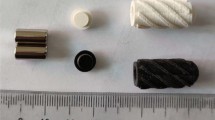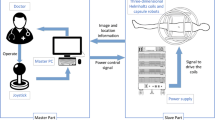Abstract
This paper proposes an intestine capsule robot with variable diameter. It is driven by external rotating magnetic field and has the function of automatic radial clearance compensation. An external magnetic field generating device and a capsule robot with variable diameter are developed. Radial dynamic balance equation and kinematics equation of the capsule robot traveling inside flexible elasto-wall environment are established, and dynamic characteristics of the capsule robot inside flexible elasto-wall pipe and rigid wall pipe environments are analyzed and compared. Simulations and experiment results show that its dynamic characteristics in both pipes are almost the same. Under the action of radial clearance compensation, fluid dynamic pressure around outer surface of the capsule robot and its propulsion, as well as its adaptability to diameter change range, are significantly improved. Its propulsion and moving speed are controlled by adjusting rotating angular speed of the rotating magnetic field. This innovative capsule robot with radial clearance compensation has a promising prospect for inside intricate gastrointestinal (GI) tract in non-invasive therapy applications.
Similar content being viewed by others
References
Dario P, Hannaford B, Menciassi A. Smart surgical tools and augmenting devices. IEEE Trans Rob Autom, 2003, 19: 782–791
MacFadyen B V, Cuschieri A. Endoluminal surgery. Surg Endosc, 2005, 19: 1–3
Cuschieri A, Melzer A. The impact of technologies on minimally invasive therapy. Surg Endosc, 1997, 11: 91–92
Cuschieri A. Minimally invasive surgery: Hepatobiliary-pancreatic and foregut. Endosc, 2000, 32: 331–344
Schostek S, Fischer H, Kalanovic D, et al. Microsystems in medicine —Results of an international survey. Minimally Invasive Therapy Allied Technol, 2005: 14, 360–368
Swain P, Iddan G, Meron G, et al. Wireless capsule endoscopy of the small bowel: Development, testing and first human trials. Proc SPIE, 2001, 41: 19–23
Iddan G, Meron G, Glukhovsky A, et al. Wireless capsule endoscopy. Nature, 2000, 405: 417–418
Meron G. The development of the swallable video capsule (M2A). Gastrointest Endosc, 2000, 52: 817–819
RF System Lab, NORIKA3. Available.(English): http://www.rfamerica.com/sayaka/ (Japanese), 2001
Olympus. http://www.olympus-globle.co-m/en/news/2005b/nr051013capsle.cfm, 2008
Jian X Y, Mei T, Wang X H. Driving method of an endoscopic robot capsule by external magnetic field. Robot, 2005, 27: 367–372
Zabulis X, Sfakiotakis M, Tsakiris D P. Effects of vibratory actuation on endoscopic capsule vision. In: 30th Ann Int IEEE EMBS Conf, 2008, 5901–5904
Phee L, Accoto D, Menciassi A, et al. Analysis and development of locomotion devices for the gastrointestinal tract. IEEE Trans Biomed Eng, 2002, 49: 613–616
Phee L, Menciassi A, Gorini S, et al. An innovative locomotion principle for minirobots moving in the gastrointestinal tract. In: Proc IEEE Int Conf Rob Autom, 2002, 1125–1130
Dario P, Ciarletta P, Menciassi A, et al. Modeling and experimental validation of the locomotion of endoscopic robots in the colon. Int J Rob Res, 2004, 23: 549–556
Accoto D, Stefanini C, Phee L, et al. Measurements of the frictional properties of the gastrointestinal tract. In: The World Tri-bol Congr, Vienna, Austria, 2001
Menciassi A, Stefanini C, Gorini S, et al. Legged locomotion in the gastrointestinal tract problem analysis and preliminary technological activity. In: Proc IEEE Int Conf Intell Robots Syst, 2004, 937–942
Kassim I, Phee C L, Wan N G. Locomotion techniques for robotic colonoscopy. IEEE Eng Med Biol Maga, 2006, 25: 49–56
Wang X N, Meng M Q H. An inchworm-like locomotion mechanism based on magnetic actuator for active capsule endoscope. In: Proc IEEE/RSJ Int Conf Intell Robots Syst, 2006, 1267–1272
Guozheng Y, Qiuong L, Guoqing D, et al. The prototype of a piezoelectric medical robot. In: Proc IEEE Int Symp Microch Human Sci, 2002, 73–77
Kim B, Lee S, Park J H, et al. Design and fabrication of a locomotive mechanism for capsule-type endoscopes using shape memory alloys (SMAs).IEEE/ASME Trans Mechatron, 2005, 10: 77–86
Menciassi A, Stefanini C, Gorini S, et al. Locomotion of a legged capsule in the gastrointestinal tract: Theoretical study and preliminary technological result. In: Proc IEEE Int Conf Eng Med Biol, 2004, 26: 2767–2770
Dario P, Menciassi A, Stefanini C, et al. Teleoperated endoscopic capsule equipped with active locomotion system. Patent WO 2005082248, 2005
Quirini M, Menciassi A, Scapellato S, et al. Design and fabrication of a motor legged capsule for the active exploration of the gastrointestinal tract. IEEE/ASME Tracs Mechatron, 2008, 13: 169–179
Ikeuchi K, Yoshinaka K, Hashimoto S, et al. Locomotion of medical micro robot with spiral ribs using mucus. In: Proc IEEE Int Symp Micro Mach Human Sci, 1996, 217–222
Zhang Y, li Z G, Jing S P, et al. Characteristics of magnetic tensile force along axial direction of a capsule micro robot applied in intestine. Chin Mech Eng, 2006, 18: 1709–1719
Zhang Y, Wang D, Guo D, et al. Characteristics of magnetic torque of a capsule micro robot applied in intestine IEEE. Trans Magn (Accepted)
Lu C H, An X, Li J F. Analysis and research on spiral oil wedge hydrodynamic bearing for precise machine tool spindles. Int J Machine Tools Manuf, 1998, 38: 197–203
Zhang Y, Zhang K, Zhang L. Spiral drive characteristics of a micro robot inside human body. Robot, 2006, 28: 560–570
Pinkus O, Sternlicht B. Theory of Hydrodynamic Lubrication. New York: McGraw Hill Co., 1961
Gent A N. Engineering with Rubber-How to Design Rubber Components. New York: Hanser Gardner Publications, 2001
Author information
Authors and Affiliations
Corresponding author
About this article
Cite this article
Zhang, Y., Jiang, S., Zhang, X. et al. Dynamic characteristics of an intestine capsule robot with variable diameter. Chin. Sci. Bull. 55, 1813–1821 (2010). https://doi.org/10.1007/s11434-009-3370-6
Received:
Accepted:
Published:
Issue Date:
DOI: https://doi.org/10.1007/s11434-009-3370-6




